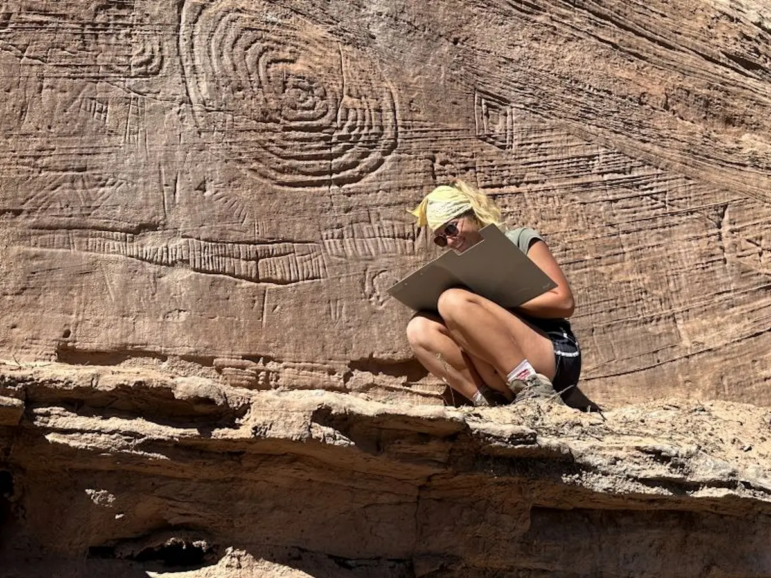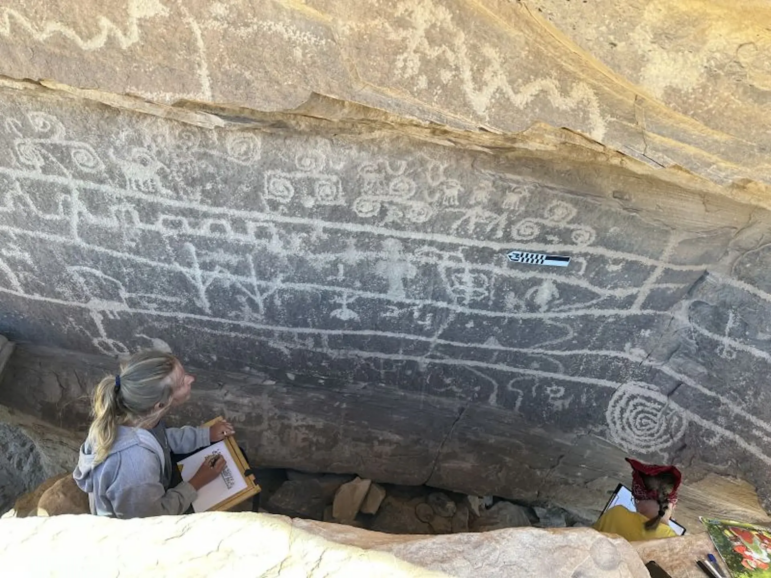The Wild Hunt
Source - https://wildhunt.org/2024/01/castle-rock-reveals-an-ancient-native-american-calendar.html
Castle Rock Pueblo is a village in the Mesa Verde region of Colorado. It is part of a large ancient settlement complex in Mesa Verde National Park, on the border between Colorado and Utah. Castle Rock Pueblo was built around the Castle Rock buttes, which are located near the western-most Sand Canyon parking lot.
The village was home to 75 to 150 people from about 1260 CE until the 1290 CE. It is the largest village in the complex, which is carved into rock faces in the area’s canyons. The villages are characteristic of the Pueblo culture that flourished in the 12th and 13th centuries.
Now, new research conducted by archeologists collaborating with Ute tribe members is revealing some new details about the site.
Poland’s Jagiellonian University (JU) archeologists have unearthed an ancient Native American calendar at the Castle Rock Pueblo archeological site in western Colorado, revealing remnants of an ancient settlement. The petroglyphs at the site, dating back to the third century AD, include previously unstudied rock panels from the 13th century, the peak of the site’s activity.
Radosław Palonka, the leader of the Polish research team, views these findings as the initiation of a novel exploration phase, utilizing advanced mapping technology and collaborating with local Indigenous communities to gain deeper insights into the region.
Castle Rock stands as the largest village within an extensive ancient settlement complex in Colorado’s Mesa Verde National Park. These villages, intricately carved into the rock faces of the area’s canyons, reflect the distinctive Pueblo culture that thrived in the 12th and 13th centuries.
Over a millennium of habitation in the region, the Pueblo peoples developed sophisticated architectural techniques, constructing fortified terraced structures with intricate rectangular adobe rooms. Strategic defensive positions, such as hilltops, mesas, and steep rock ledges, were preferred locations for construction within the Castle Rock Complex.
 The ancient petroglyphs at Colorado’s Mesa Verde National Park are being analyzed by researchers. Photo Credit: Jagiellonian University
The ancient petroglyphs at Colorado’s Mesa Verde National Park are being analyzed by researchers. Photo Credit: Jagiellonian University
“I had some hints from older members of the local community that something more can be found in the higher, less accessible parts of the canyons. We wanted to verify this information, and what we found surpassed our wildest expectations,” Palonka said in a statement. “It turned out that about 800 metres above the cliff settlements there are a lot [of] previously unknown petroglyphs. The huge rock panels stretch over 4km around the large plateau.
“These discoveries forced us to adjust our knowledge about this area,” Palonka continued. “Definitely we have underestimated the number of inhabitants who lived here in the 13th century and the complexity of their religious practices, which must have also taken place next to these outdoor panels.”
Pueblo sites share a common feature in their rock art, portraying scenes of daily life, intricate geometric patterns, and astronomical themes. The recent discoveries by JU archeologists focus on petroglyphs carved into previously overlooked or deemed inaccessible ledges.
Among these findings are carvings from the Basketmaker Era of the first centuries AD, depicting warriors and shamans — the predecessors to the Pueblo people. The majority of the unearthed artifacts, however, originate from the zenith of Pueblo culture in the 13th century. During this period, the large population residing in nearby adobe structures carved shapes and spirals, some up to a meter in size, suggesting potential religious significance. Additionally, later carvings from the Ute tribe depict narrative scenes of hunting and the post-Columbian introduction of horses to the region.
The ongoing exploration of the site will adopt a dual approach, involving collaboration with the University of Houston’s LiDAR team and engaging local Ute tribe members. This collaborative effort aims to create highly detailed digital maps and comprehensive historical records of the archeological site.
Palonka expressed enthusiasm about the collaboration with the Texan scientists, anticipating the development of “a detailed 3D map of the area with a resolution of 5cm-10cm,” marking a significant advancement from current imaging capabilities. Palonka’s team eagerly anticipates the outcomes of the new mapping efforts, expressing the hope of identifying previously undiscovered sites, particularly from earlier historical periods.
 Ancient petroglyphs shed light on the calendar in Colorado’s Mesa Verde National Park
Ancient petroglyphs shed light on the calendar in Colorado’s Mesa Verde National Park
The team, with the support of Ute tribal archeologist Rebecca Hammond, will benefit from assistance in comprehending and contextualizing the discovered artifacts.
According to Jagiellonian University, the Pueblo people shared very meaningful dialogues with archeologists and the Indigenous community will play a pivotal role in curating a forthcoming and enduring exhibit at the nearby Canyon of the Ancients Visitor Centre and Museum. This exhibit will showcase the latest findings of the Polish research team.